
Diophantus of Alexandria was a Greek mathematician, who was the author of a series of books called Arithmetica, many of which are now lost. His texts deal with solving algebraic equations.
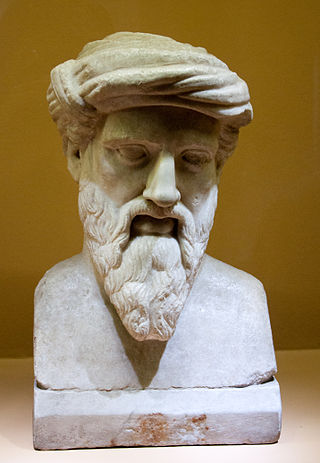
Pythagoras of Samos was an ancient Ionian Greek philosopher, polymath and the eponymous founder of Pythagoreanism. His political and religious teachings were well known in Magna Graecia and influenced the philosophies of Plato, Aristotle, and, through them, the West in general. Knowledge of his life is clouded by legend, but he appears to have been the son of Mnesarchus, a gem-engraver on the island of Samos or the city of Tyre. Modern scholars disagree regarding Pythagoras's education and influences, but they do agree that, around 530 BC, he travelled to Croton in southern Italy, where he founded a school in which initiates were sworn to secrecy and lived a communal, ascetic lifestyle. This lifestyle entailed a number of dietary prohibitions, traditionally said to have included vegetarianism, although modern scholars doubt that he ever advocated complete vegetarianism; he was said to have advised athletes to "feast on flesh" exclusively.
Alastor refers to a number of people and concepts in Greek mythology:

Aristoxenus of Tarentum was a Greek Peripatetic philosopher, and a pupil of Aristotle. Most of his writings, which dealt with philosophy, ethics and music, have been lost, but one musical treatise, Elements of Harmony, survives incomplete, as well as some fragments concerning rhythm and meter. The Elements is the chief source of our knowledge of ancient Greek music.
The sibyls were prophetesses or oracles in Ancient Greece. The sibyls prophesied at holy sites. A sibyl at Delphi has been dated to as early as the eleventh century BC by Pausanias when he described local traditions in his writings from the second century AD. At first, there appears to have been only a single sibyl. By the fourth century BC, there appear to have been at least three more, Phrygian, Erythraean, and Hellespontine. By the first century BC, there were at least ten sibyls, located in Greece, Italy, the Levant, and Asia Minor.
Maximus Planudes was a Byzantine Greek monk, scholar, anthologist, translator, mathematician, grammarian and theologian at Constantinople. Through his translations from Latin into Greek and from Greek into Latin, he brought the Greek East and the Latin West into closer contact with one another. He is now best known as a compiler of the Greek Anthology.
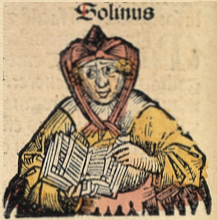
Gaius Julius Solinus, better known simply as Solinus, was a Latin grammarian, geographer, and compiler who probably flourished in the early 3rd century AD. Historical scholar Theodor Mommsen dates him to the middle of the 3rd century.

Pythagoreanism originated in the 6th century BC, based on and around the teachings and beliefs held by Pythagoras and his followers, the Pythagoreans. Pythagoras established the first Pythagorean community in the ancient Greek colony of Kroton, in modern Calabria (Italy). Early Pythagorean communities spread throughout Magna Graecia.
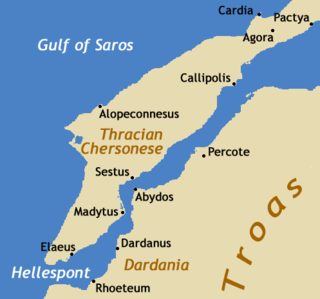
Sestos was an ancient city in Thrace. It was located at the Thracian Chersonese peninsula on the European coast of the Hellespont, opposite the ancient city of Abydos, and near the town of Eceabat in Turkey.

The Sibylline Oracles are a collection of oracular utterances written in Greek hexameters ascribed to the Sibyls, prophetesses who uttered divine revelations in a frenzied state. Fourteen books and eight fragments of Sibylline Oracles survive, in an edition of the 6th or 7th century AD. They are not to be confused with the original Sibylline Books of the ancient Etruscans and Romans which were burned by order of the Roman general Flavius Stilicho in the 4th century AD. Instead, the text is an "odd pastiche" of Hellenistic and Roman mythology interspersed with Jewish, Gnostic and early Christian legend.
Quintus Fabius Pictor was the earliest known Roman historian. His history, written in Greek and now mostly lost besides some surviving fragments, was highly influential on ancient writers and certainly participated in introducing Greek historiographical methods to the Roman world. However, the work was highly partisan towards Rome, blaming the Second Punic War on Carthage and idealizing the Roman Republic as a well-ordered state loyal to its allies. Fabius probably served as praetor, was a member of the Senate, and participated in a delegation sent to the oracle at Delphi in 216 BC. Some scholars consider him one of the earliest annalists, although this conclusion has been criticized.

Iamblichus was a Syrian neoplatonic philosopher of Arabic origin. He determined a direction later taken by neoplatonism. Iamblichus was also the biographer of the Greek mystic, philosopher, and mathematician Pythagoras. In addition to his philosophical contributions, his Protrepticus is important for the study of the sophists because it preserved about ten pages of an otherwise-unknown sophist known as the Anonymus Iamblichi.
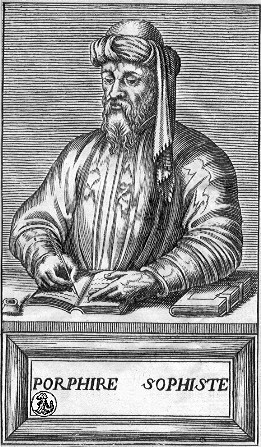
Porphyry of Tyre was a Neoplatonic philosopher born in Tyre, Roman Phoenicia during Roman rule. He edited and published The Enneads, the only collection of the work of Plotinus, his teacher.
Oneiromancy is a form of divination based upon dreams, and also uses dreams to predict the future. Oneirogen plants may also be used to produce or enhance dream-like states of consciousness. Occasionally, the dreamer feels as if they are transported to another time or place, and this is offered as evidence they are in fact providing divine information upon their return.
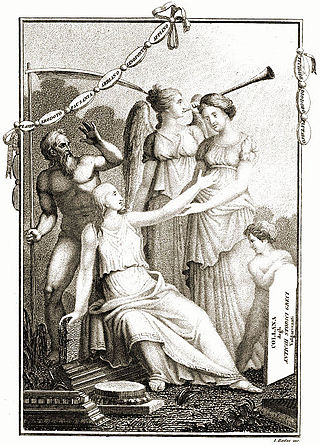
Polyaenus or Polyenus was a 2nd-century CE Greek author, known best for his Stratagems in War, which has been preserved. He was born in Bithynia. The Suda calls him a rhetorician, and Polyaenus himself writes that he was accustomed to plead causes before the Roman emperor. Polyaenus dedicated Stratagems in War to the two emperors Marcus Aurelius and Lucius Verus, while they were engaged in the Roman–Parthian War of 161–166, about 163, at which time he was too old to accompany them in their campaigns.

The Greek Magical Papyri is the name given by scholars to a body of papyri from Graeco-Roman Egypt, written mostly in ancient Greek, which each contain a number of magical spells, formulae, hymns, and rituals. The materials in the papyri date from the 100s BCE to the 400s CE. The manuscripts came to light through the antiquities trade, from the 1700s onward. One of the best known of these texts is the Mithras Liturgy.

Byzantine science played an important role in the transmission of classical knowledge to the Islamic world and to Renaissance Italy, and also in the transmission of Islamic science to Renaissance Italy. Its rich historiographical tradition preserved ancient knowledge upon which splendid art, architecture, literature and technological achievements were built. Byzantines stood behind several technological advancements.

The Bylliones were an Illyrian tribe that lived near the Adriatic coast of southern Illyria, on the lower valley of the Vjosa river, in the hinterland of Apollonia. The Bylliones were firstly attested in epigraphic material from the oracle of Dodona dating back to the 4th century BC, and their koinon was firstly attested in a 3rd century BC inscription from the same oracle. Their territory was trapezoidal on the right side of the rivers Luftinje and Vjosa, extending in the west to the Mallakastra mountains. The chief city of their koinon was Byllis. Another important centre of their koinon was Klos, an earlier Illyrian settlement later called Nikaia, as an inscription attests. The Bylliones also inhabited in the area of an ancient sanctuary of the eternal fire called Nymphaion.

Ipse dixit is an assertion without proof, or a dogmatic expression of opinion.

The Exhortation to the Greeks is an Ancient Greek Christian paraenetic or protreptic text in thirty-eight chapters.















